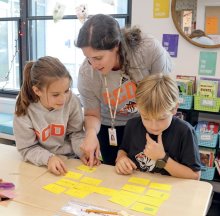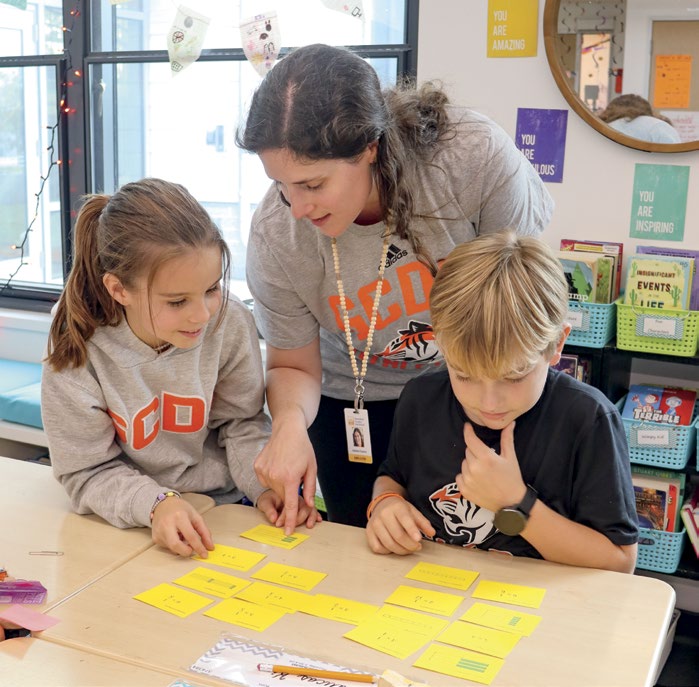
Tell me how your brain is solving this math problem,” Jacey Hanson, a third-grade teacher, says to her class as the students subtract numbers in their heads for the morning lesson.
Several thumbs go up (her classroom version of raising hands). One student explains that 200 minus 98 is 102 because she knows that 100 minus 98 is 2 and then she adds 100 more. Another student explains that he knows that 200 minus 100 is 100 and then he adds a 2.
Hanson, a longtime teacher but only in her second year at GCDS, has never seen students do mental math as well as her current students. “They have such a strong sense of numbers and know multiple strategies to mentally solve multiple digit addition,” she says. “And the best part is that they are able to explain their thinking. I’ve been so impressed that I’ve asked to see how they are teaching in the lower grades.”
The GCDS math team is working across all grades to facilitate mathematical proficiency that is built upon conceptual understanding. This powerful approach promotes longer-term retention in students and lays the groundwork for the study of advanced mathematics in higher grades and beyond. Beginning in the earliest years, the goal is to create a learning environment that is rich in problem-solving, collaboration, and communication.
“Our mathematics program is constantly evolving to reflect the most current and research-supported practices and resources in our field,” says Trish Kepler, GCDS Director of Mathematics, Nursery–Grade 5.
“Many of us have achieved procedural fluency in a vacuum, in which fast and accurate were valued over understanding,” says Kepler. “When procedural fluency develops at the service of deep understanding, the learning is stickier, and students can use this as a lever to apply their knowledge to novel and complex problems.”
“In many K–5 programs, heavy emphasis is placed on arithmetic using big numbers fast, typically using a more algorithmic approach. This focus is short-sighted. In fact, computing with whole numbers is such a narrow component of mathematics, and students who lean so heavily on more traditional algorithms often develop gaps in number sense and understanding of operations that negatively impact their future achievement in mathematics.”
For the past two years, classes at GCDS from Kindergarten through Grade 5 have been using a curriculum called Illustrative Mathematics (IM), a problem-based curriculum that cultivates an understanding of mathematical concepts through a repeated cycle of doing math problems and explaining in a group discussion how it was solved.
Kepler believes that the philosophy at the heart of the IM program positions GCDS students for success in their later study of math as well as contributes to a skill set that transcends into other subject areas and aspects of life.
“Discovering patterns and finding relationships makes learning math an opportunity for discovery and curiosity rather than a subject of rote memorization,” says Steph Lehn, a fourth-grade teacher. “Yes, there are procedures and shortcuts all students will leave fifth grade having been taught, but the way we get there is much more engaging and thought-provoking than how most of us adults experienced math.”
When students are introduced to the more traditional algorithm that is more familiar to adults, they understand how and why it works because it is a natural extension of the strategies that they already understand.
A typical math lesson for K–5 begins with a warm-up routine that previews the lesson. During the warm-up routine, all students are encouraged to share their ideas, ask questions, and respond to the thinking of other members of their math community. The warm-up routine provides a daily opportunity to strengthen number sense and build procedural fluency. Afterward, students enter a cycle of doing math and synthesizing ideas. Here, teachers facilitate discussions and encourage students to articulate their reasoning and share their perspectives. These carefully curated daily discoveries contribute to big-picture understanding over the course of each unit. Regularly administered “cool-downs” and “checkpoints” help teachers to measure learning and make decisions about instructional next steps.
This consistent, disciplined routine plays out daily, annually, and over the course of many years building upon and increasing students’ conceptual understanding of critical math content through realistic contexts.
“I like how every time we start math, we start with a warm-up so lots of people get a chance to share,” says Siena, a fourth grade student. “During our cool-downs and checkpoints, we have to explain our thinking, which helps me to really learn the math.”
Strategically sequenced routines and tasks put student thinking at the center of the learning experience. “This approach elicits understanding from students that teachers can leverage to drive learning,” says Ms. Kepler.
For Luke Laubscher, a fourth grade teacher, this approach shifts the dynamic of learning markedly in the classroom. “Historically, math was the teacher in front of the room, holding the knowledge as an expert and disseminating it throughout the lesson while the children listened. Through the careful use of conversations and syntheses at the end of each activity, responsibility of knowledge becomes communal. The shift, during which students drive the learning and I am a guide, is profound and helps the students build important growth mindset mentalities. They see themselves and others in the room as integral to their collective success.”
Ms. Hanson loves the energy and excitement that math creates in her classroom. “At times, our classroom feels and sounds like we’re in the mission control room at NASA, tapping into everyone’s capacities to solve the problem at hand. There have been so many aha moments.”


.jpg&command_2=resize&height_2=85)



.png&command_2=resize&height_2=85)


.jpg&command_2=resize&height_2=85)








.jpg&command_2=resize&height_2=85)



